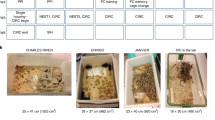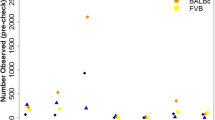Abstract
Outbred mouse stocks, often used in genetics, toxicology and pharmacology research, have been generated in rather haphazard ways. Understanding the characteristics of these stocks and their advantages and disadvantages is important for experimental design. In many studies these mice are used inappropriately, wasting animals' lives and resources on suboptimal experiments. Recently, however, researchers from the field of complex trait analysis have capitalized on the genetics of outbred stocks to refine the identification of quantitative trait loci. Here we assess the most widely used outbred stocks of mice and present guidelines for their use.
This is a preview of subscription content, access via your institution
Access options
Subscribe to this journal
Receive 12 print issues and online access
$209.00 per year
only $17.42 per issue
Buy this article
- Purchase on Springer Link
- Instant access to full article PDF
Prices may be subject to local taxes which are calculated during checkout

Similar content being viewed by others
References
Beck, J.A. et al. Genealogies of mouse inbred strains. Nat. Genet. 24, 23–25 (2000).
Festing, M.F.W. International Index of Laboratory Animals 6th edn. (Newbury, England, 1993).
Festing, M.F. Genetic reliability of commercially-bred laboratory mice. Lab. Anim. 8, 265–270 (1974).
Festing, M.F. Genetic monitoring of laboratory mouse colonies in the Medical Research Council Accreditation Scheme for the suppliers of laboratory animals. Lab. Anim. 8, 291–299 (1974).
Cui, S., Chesson, C. & Hope, R. Genetic variation within and between strains of outbred Swiss mice. Lab. Anim. 27, 116–123 (1993).
Hayakawa, J., Koizumi, T. & Natsuume-Sakai, S. Constancy of genetic variability in mice for non-inbred closed colonies. Lab. Anim. 14, 233–236 (1980).
Strivens, M. & Eppig, J.T. Visualizing the laboratory mouse: capturing phenotype information. Genetica 122, 89–97 (2004).
Falconer, D.S. Introduction to Quantitative Genetics (Longmans, London, 1981).
Festing, M., Kondo, K., Loosli, R., Poiley, S.M. & Spiegel, A. International standardized nomenclature for outbred stocks of laboratory animals. Z. Versuchstierkd. 14, 215–224 (1972).
Festing, M.F. Warning: the use of heterogeneous mice may seriously damage your research. Neurobiol. Aging 20, 237–244 (1999).
Holt, M., Nicholas, F.W., James, J.W., Moran, C. & Martin, I.C. Development of a highly fecund inbred strain of mice. Mamm. Genome 15, 951–959 (2004).
Nomura, T. & Yonezawa, K. A comparison of four systems of group mating for avoiding inbreeding. Genet. Sel. Evol. 28, 141–159 (1996).
Groen, A. & Lagerwerf, A.J. Genic heterogeneity and genetic monitoring of mouse outbred stocks. Lab. Anim. 13, 81–85 (1979).
Katoh, H., Utsu, S., Chen, T.P. & Moriwaki, K. H-2 polymorphisms in outbred strains of mice. Lab. Anim. Sci. 40, 490–494 (1990).
Kluge, R., Meyer, J. & Rapp, K.G. Genetic characterization of the mouse strains of the Institute for Animal Breeding of the Veterinary Faculty of the University of Munich, Germany. J. Exp. Anim. Sci. 36, 179–188 (1994).
Rice, M.C. & O'Brien, S.J. Genetic variance of laboratory outbred Swiss mice. Nature 283, 157–161 (1980).
Teppner, I., Aigner, B., Schreiner, E., Muller, M. & Windisch, M. Polymorphic microsatellite markers in the outbred CFW and ICR stocks for the generation of speed congenic mice on C57BL/6 background. Lab. Anim. 38, 406–412 (2004).
Boucher, W. & Cotterman, C.W. On the classification of regular systems of inbreeding. J. Math. Biol. 28, 293–305 (1990).
Caballero, A. & Toro, M.A. Interrelations between effective population size and other pedigree tools for the management of conserved populations. Genet. Res. 75, 331–343 (2000).
Petkov, P.M. et al. An efficient SNP system for mouse genome scanning and elucidating strain relationships. Genome Res. 14, 1806–1811 (2004).
Russell, R.J., Festing, M.F., Deeny, A.A. & Peters, A.G. DNA fingerprinting for genetic monitoring of inbred laboratory rats and mice. Lab. Anim. Sci. 43, 460–465 (1993).
Hoger, H. Genetic drift in an outbred stock of mice. Jikken Dobutsu 41, 215–220 (1992).
Chapin, R.E. et al. Are mouse strains differentially susceptible to the reproductive toxicity of ethylene glycol monomethyl ether? A study of three strains. Fundam. Appl. Toxicol. 21, 8–14 (1993).
Poiley, S.M. Growth tables for 66 strains and stocks of laboratory animals. Lab. Anim. Sci. 22, 758–779 (1972).
Papaioannou, V.E. & Festing, M.F. Genetic drift in a stock of laboratory mice. Lab. Anim. 14, 11–13 (1980).
Serfilippi, L.M., Pallman, D.R., Gruebbel, M.M., Kern, T.J. & Spainhour, C.B. Assessment of retinal degeneration in outbred albino mice. Comp. Med. 54, 69–76 (2004).
Nei, M. Estimation of average heterozygosity and genetic distance from a small number of individuals. Genetics 89, 583–590 (1978).
Lynch, C.J. The so-called Swiss mouse. Lab. Anim. Care 19, 214–220 (1969).
Jay, G.E. Jr. Variation in response of various mouse strains to hexobarbital (evipal). Proc. Soc. Exp. Biol. Med. 90, 378–380 (1955).
Dell, R.B., Holleran, S. & Ramakrishnan, R. Sample size determination. ILAR J. 43, 207–213 (2002).
Festing, M.F. Principles: the need for better experimental design. Trends Pharmacol. Sci. 24, 341–345 (2003).
Felton, R.P. & Gaylor, D.W. Multistrain experiments for screening toxic substances. J. Toxicol. Environ. Health 26, 399–411 (1989).
Festing, M.F. & Wolff, G.L. Re: Inbred strains of laboratory animals: superior to outbred mice? J. Natl. Cancer Inst. 87, 1715–1716 (1995).
Haseman, J.K. & Hoel, D.G. Statistical design of toxicity assays: role of genetic structure of test animal population. J. Toxicol. Environ. Health 5, 89–101 (1979).
Festing, M.F., Diamanti, P. & Turton, J.A. Strain differences in haematological response to chloramphenicol succinate in mice: implications for toxicological research. Food Chem. Toxicol. 39, 375–383 (2001).
Flint, J., Valdar, W., Shifman, S. & Mott, R. Strategies for mapping and cloning quantitative trait genes in rodents. Nat. Rev. Genet. 6, 271–286 (2005).
Hitzemann, R. et al. Multiple cross mapping (MCM) markedly improves the localization of a QTL for ethanol-induced activation. Genes Brain Behav. 1, 214–222 (2002).
Manenti, G., Galbiati, F., Noci, S. & Dragani, T.A. Outbred CD-1 mice carry the susceptibility allele at the pulmonary adenoma susceptibility 1 (Pas1) locus. Carcinogenesis 24, 1143–1148 (2003).
Mott, R., Talbot, C.J., Turri, M.G., Collins, A.C. & Flint, J. A method for fine mapping quantitative trait loci in outbred animal stocks. Proc. Natl. Acad. Sci. USA 97, 12649–12654 (2000).
Talbot, C.J. et al. High-resolution mapping of quantitative trait loci in outbred mice. Nat. Genet. 21, 305–308 (1999).
Talbot, C. J. et al. Fine scale mapping of a genetic locus for conditioned fear. Mamm. Genome 14, 223–230 (2003).
Yalcin, B. et al. Genetic dissection of a behavioral quantitative trait locus shows that Rgs2 modulates anxiety in mice. Nat. Genet. 36, 1197–1202 (2004).
Demarest, K., Koyner, J., McCaughran, J. Jr., Cipp, L. & Hitzemann, R. Further characterization and high-resolution mapping of quantitative trait loci for ethanol-induced locomotor activity. Behav. Genet. 31, 79–91 (2001).
McClearn, G.E., Wilson, J.R. & Meredith, W. Contributions to Behaviour-Genetic Analysis: The Mouse as a Prototype 3–22 (Appleton Centry Crofts, New York, 2005).
Padeh, B., Wahlsten, D. & DeFries, J.C. Operant discrimination learning and operant bar-pressing rates in inbred and heterogeneous laboratory mice. Behav. Genet. 4, 383–393 (1974).
DeFries, J.C., Wilson, J.R., Erwin, V.G. & Petersen, D.R.L.S.X. SS recombinant inbred strains of mice: initial characterization. Alcohol. Clin. Exp. Res. 13, 196–200 (1989).
Feingold, N. et al. Polygenic regulation of antibody synthesis to sheep erythrocytes in the mouse: a genetic analysis. Eur. J. Immunol. 6, 43–51 (1976).
Schlager, G. Genetic Hypertension in the Mouse 158–172 (Elsevier, Amsterdam, 1994).
Boutwell, R.K. Some biological aspects of skin carcinogenesis. Prog. Exp. Tumor Res. 19, 207–250 (1964).
Mathews, C.E., Bagley, R. & Leiter, E.H. ALS/Lt: a new type 2 diabetes mouse model associated with low free radical scavenging potential. Diabetes 53 Suppl 1, S125–S129 (2004).
Garland, T., Jr et al. Evolution of a small-muscle polymorphism in lines of house mice selected for high activity levels. Evolution Int. J. Org. Evolution 56, 1267–1275 (2002).
Kirkpatrick, B.W., Mengelt, A., Schulman, N. & Martin, I.C. Identification of quantitative trait loci for prolificacy and growth in mice. Mamm. Genome 9, 97–102 (1998).
Horvat, S. et al. Mapping of obesity QTLs in a cross between mouse lines divergently selected on fat content. Mamm. Genome 11, 2–7 (2000).
Crabbe, J.C., Belknap, J.K. & Buck, K.J. Genetic animal models of alcohol and drug abuse. Science 264, 1715–1723 (1994).
Grahame, N.J., Li, T.K. & Lumeng, L. Selective breeding for high and low alcohol preference in mice. Behav. Genet. 29, 47–57 (1999).
Tabakoff, B., Bhave, S.V. & Hoffman, P.L. Selective breeding, quantitative trait locus analysis, and gene arrays identify candidate genes for complex drug-related behaviors. J. Neurosci. 23, 4491–4498 (2003).
Biozzi, G. et al. Genetic analysis of antibody responsiveness to sheep erythrocytes in crosses between lines of mice selected for high or low antibody synthesis. Immunology 36, 427–438 (1979).
Baker, D. et al. Induction of chronic relapsing experimental allergic encephalomyelitis in Biozzi mice. J. Neuroimmunol. 28, 261–270 (1990).
Tinston, D.J., Chart, I.S., Godley, M.J., Gore, C.W.G.B.A. & Litchfield, M.H. Chlorodifluoromethane (CFC 22): Long Term Inhalation Study in the Mouse. Report No. CTL/P/547. (Imperial Chemical Industries Limited, Central Toxicology Laboratory, Alderley Park, Cheshire, UK, 1981).
Anghileri, L.J., Mayayo, E., Domingo, J.L. & Thouvenot, P. Radiofrequency-induced carcinogenesis: cellular calcium homeostasis changes as a triggering factor. Int. J. Radiat. Biol. 81, 205–209 (2005).
Hauschka, T. S. & Mirand, E. A. Perspectives in Cancer Research and Treatment vol. 25, 319 (Roswell Park Memorial Institute, New York, 1973).
Nobunaga, T. Establishment by selective inbreeding of the IVCS strain and related sister strains of the mouse, demonstrating regularly repeated 4-day estrous cycles. Lab. Anim. Sci. 23, 803–811 (1973).
Darvasi, A. Dissecting complex traits: the geneticists' “Around the world in 80 days.” Trends Genet. 21, 373–376 (2005).
Stahl, W., Sekiguchi, M. & Kaneda, Y. Cerebellar anomalies in congenital murine toxoplasmosis. Parasitol. Res. 88, 507–512 (2002).
Benson, L.M. & Abelseth, M.K. Investigation of the histocompatibility of the NYA:NYLAR mouse colony by skin grafting. Lab. Anim. Sci. 27, 333–335 (1977).
DiGiovanni, J. Genetic factors controlling responsiveness to skin tumor promotion in mice. Prog. Clin. Biol. Res. 391, 195–212 (1995).
Hennings, H., Lowry, D.T., Yuspa, S.H., Mock, B. & Potter, M. New strains of inbred SENCAR mice with increased susceptibility to induction of papillomas and squamous cell carcinomas in skin. Mol. Carcinog. 20, 143–150 (1997).
Ku, S.K., Lee, J.H., Lee, H.S. & Park, K.D. The regional distribution and relative frequency of gastrointestinal endocrine cells in SHK-1 hairless mice: an immunohistochemical study. Anat. Histol. Embryol. 31, 78–84 (2002).
Hornady, M.H. Changes in the testicular and preputial gland structures of mice related to influence of Ferula hormonis extrtact. Sciences (New York) 1, 108–112 (2001).
Acknowledgements
We thank R.D. Mastrocco for information about Clara Lynch; J. Eppig, R. Hitzemann, H. Jacob, M. Josten, R. Kalman, I. Martin, G. McClearn, R. Mott, J. Stitzel and R. Williams for personal communications; R. Young for graphics; and the Brain Research Trust and the Motor Neuron Disease Association for funding.
Author information
Authors and Affiliations
Corresponding author
Ethics declarations
Competing interests
M.F.W.F. has a consultancy with Harlan Limited.
Supplementary information
Supplementary Fig. 1
Genealogy of major Swiss mice outbred stocks. (PDF 181 kb)
Rights and permissions
About this article
Cite this article
Chia, R., Achilli, F., Festing, M. et al. The origins and uses of mouse outbred stocks. Nat Genet 37, 1181–1186 (2005). https://doi.org/10.1038/ng1665
Published:
Issue Date:
DOI: https://doi.org/10.1038/ng1665
This article is cited by
-
Characterization of a strain-specific CD-1 reference genome reveals potential inter- and intra-strain functional variability
BMC Genomics (2023)
-
Hearing loss and tinnitus: association studies for complex-hearing disorders in mouse and man
Human Genetics (2022)
-
Comparison of intrinsic exercise capacity and response to acute exercise in ICR (Institute of Cancer Research) mice derived from three different lineages
Laboratory Animal Research (2021)
-
Phenotyping spontaneous locomotor activity in inbred and outbred mouse strains by using Digital Ventilated Cages
Lab Animal (2021)
-
A fish is not a mouse: understanding differences in background genetics is critical for reproducibility
Lab Animal (2021)



